#2I/Borisov
Text
Astronomy Highlights, 2019
In 2019, the field of astronomy was filled with groundbreaking discoveries that captivated the world’s attention. Here are ten of the most widely covered astronomical discoveries of the year:
First-ever image of a black hole – In April 2019, astronomers released the first-ever image of a black hole located in the galaxy Messier 87. The image was captured by the Event Horizon Telescope, an…
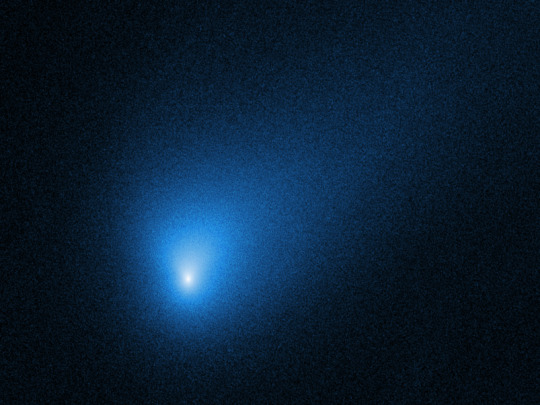
View On WordPress
#2I/Borisov#astronomy#black holes#comets#dark matter#exoplanets#fast radio burst#K2-18b#Kepler-47 system#Messier 87#neutron stars#Planet Nine#universe#white dwarf star
4 notes
·
View notes
Text
Ze willen zoeken op de oceaanbodem naar een interstellaire meteoriet die in 2014 op aarde neerkwam
Ze willen zoeken op de oceaanbodem naar een interstellaire meteoriet die in 2014 op aarde neerkwam
Een voorbeeld van een heldere meteoor, in dit geval een Leonide. Credit: Navicore/Wikipedia.
Op 8 januari 2014 was een heldere meteoor zichtbaar in Azië, die als meteoriet ergens neerplonste voor de kust van Papoea Nieuw Guinea. Zoiets komt iedere dag wel voor, zo’n meteoriet uit de ruimte die neerkomt op aarde. Maar met CNEOS 2014-01-08, zoals de meteoriet door het leven gaat, was iets anders…

View On WordPress
0 notes
Text
Ze willen zoeken op de oceaanbodem naar een interstellaire meteoriet die in 2014 op aarde neerkwam
Ze willen zoeken op de oceaanbodem naar een interstellaire meteoriet die in 2014 op aarde neerkwam
Een voorbeeld van een heldere meteoor, in dit geval een Leonide. Credit: Navicore/Wikipedia.
Op 8 januari 2014 was een heldere meteoor zichtbaar in Azië, die als meteoriet ergens neerplonste voor de kust van Papoea Nieuw Guinea. Zoiets komt iedere dag wel voor, zo’n meteoriet uit de ruimte die neerkomt op aarde. Maar met CNEOS 2014-01-08, zoals de meteoriet door het leven gaat, was iets anders…

View On WordPress
0 notes
Photo
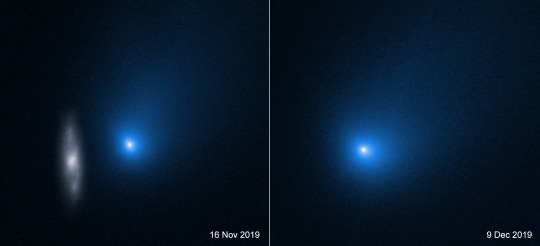
Interstellar Comet 2I Borisov : From somewhere else in the Milky Way galaxy, Comet 2I/Borisov was just visiting the Solar System. Discovered by amateur astronomer Gennady Borisov on August 30, 2019, the first known interstellar comet is seen in these two Hubble Space Telescope images from November and December 2019. On the left, a distant background galaxy near the line-of-sight to Borisov is blurred as Hubble tracked the speeding comet and dust tail about 327 million kilometers from Earth. At right, 2I/Borisov appears shortly after perihelion, its closest approach to Sun. European Southern Observatory observations indicate that this comet may never have passed close to any star before its 2019 perihelion passage. Borisov's closest approach to our fair planet, a distance of about 290 million kilometers, came on December 28, 2019. Even though Hubble's sharp images don't resolve the comet's nucleus, they did lead to estimates of less than 1 kilometer for its diameter. via NASA
330 notes
·
View notes
Photo
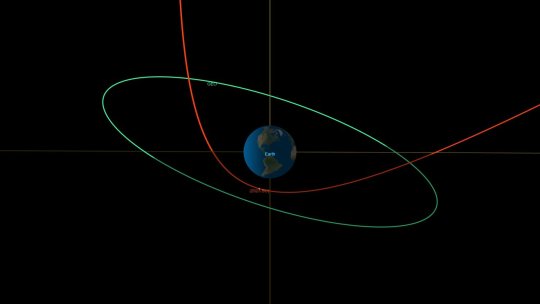
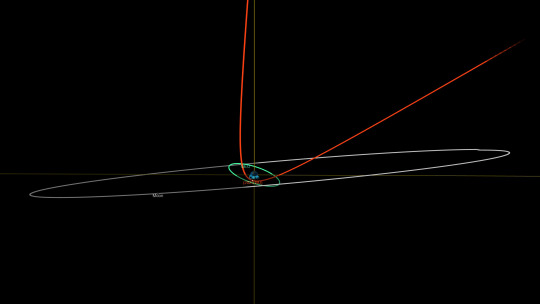
NASA System Predicts Small Asteroid to Pass Close by Earth today Asteroid 2023 BU is about the size of a box truck and is predicted to make one of the closest approaches by a near-Earth object ever recorded. On Thursday, Jan. 26, a small near-Earth asteroid will have a very close encounter with our planet. Designated 2023 BU, the asteroid will zoom over the southern tip of South America at about 4:27 p.m. PST (7:27 p.m. EST) only 2,200 miles (3,600 kilometers) above the planet’s surface and well within the orbit of geosynchronous satellites. There is no risk of the asteroid impacting Earth. But even if it did, this small asteroid – estimated to be 11.5 to 28 feet (3.5 to 8.5 meters) across – would turn into a fireball and largely disintegrate harmlessly in the atmosphere, with some of the bigger debris potentially falling as small meteorites. The asteroid was discovered by amateur astronomer Gennadiy Borisov, discoverer of the interstellar comet 2I/Borisov, from his MARGO observatory in Nauchnyi, Crimea, on Saturday, Jan. 21. Additional observations were reported to the Minor Planet Center (MPC) – the internationally recognized clearinghouse for the position measurements of small celestial bodies – and the data was then automatically posted to the Near-Earth Object Confirmation Page. After sufficient observations were collected, the MPC announced the discovery. Within three days, a number of observatories around the world had made dozens of observations, helping astronomers better refine 2023 BU’s orbit. NASA’s Scout impact hazard assessment system, which is maintained by the Center for Near Earth Object Studies (CNEOS) at the agency’s Jet Propulsion Laboratory in Southern California, analyzed the data from the MPC’s confirmation page and quickly predicted the near miss. CNEOS calculates every known near-Earth asteroid orbit to provide assessments of potential impact hazards in support of NASA’s Planetary Defense Coordination Office (PDCO). “Scout quickly ruled out 2023 BU as an impactor, but despite the very few observations, it was nonetheless able to predict that the asteroid would make an extraordinarily close approach with Earth,” said Davide Farnocchia, a navigation engineer at JPL who developed Scout. “In fact, this is one of the closest approaches by a known near-Earth object ever recorded.” While any asteroid in Earth’s proximity will experience a change in trajectory due to our planet’s gravity, 2023 BU will come so close that its path around the Sun is expected to be significantly altered. Before encountering Earth, the asteroid’s orbit around the Sun was roughly circular, approximating Earth’s orbit, taking 359 days to complete its orbit about the Sun. After its encounter, the asteroid’s orbit will be more elongated, moving it out to about halfway between Earth’s and Mars’ orbits at its farthest point from the Sun. The asteroid will then complete one orbit every 425 days.
26 notes
·
View notes
Text
Otra nave vigía podría ser enviada por extraterrestres para investigarnos como Oumuamua
Veamos
Finalmente tenemos los medios tecnológicos para detectar objetos interestelares. Hemos detectado dos en los últimos años, ‘Oumuamua y 2I/Borisov, y sin duda hay más por ahí. Como tal, ha habido mucho interés en desarrollar una misión que pueda visitar uno una vez que lo detectemos. Pero, ¿cómo sería una misión así? Ahora, un borrador de un documento de un equipo de científicos principalmente…

View On WordPress
3 notes
·
View notes
Link
Astronomers have discovered two known interstellar objects (ISO), ‘Oumuamua and 21/Borisov. But there could be thousands of these objects passing through the Solar System at any time. According to a new paper, the upcoming Vera Rubin Telescope will be a fantastic interstellar object hunter, and could possibly find up to 70 objects a year coming from other star systems. The Rubin Observatory is a ground-based telescope located high in the Chilean Andes. It is expected to see first light sometime in 2025, a timeline that has already been pushed back a few times. The observatory’s 8.4-meter Simonyi Survey Telescope will take images of the sky using the highest resolution digital camera in the world, a 3,200-megapixel camera that includes the world’s largest fish-eye lens. The camera is roughly the size of a small car and weighs almost 2800 kg (6200 lbs). This survey telescope is fast-moving and will be able to scan the entire visible sky in the southern hemisphere every few nights. One of the main projects for Rubin Observatory is the Legacy Survey of Space and Time (LSST), expected to last at least 10 years. Researchers anticipate this project will gather data on more than 5 million asteroid belt objects, 300,000 Jupiter Trojans, 100,000 near-Earth objects, and more than 40,000 Kuiper belt objects. Since Rubin will be able to map the visible night sky every few days, many of these objects will be observed hundreds of times. Because of the telescope’s repeated observations, there will be an enormous amount of data to calculate the positions and orbits of all these objects. With all that data and mapping, it is expected that Rubin will be able to detect faint interstellar objects – and these speedy ISOs might even actually stand out among all the other objects. Basically, the LSST will be able to capture a timelapse view of interstellar objects on their fast journeys through our Solar System. ‘Oumuamua (l) and 2I/Borisov (r) are the only two ISOs we know of for certain. Image Credit: Left: By Original: ESO/M. Kornmesser; right, Hubble Space Telescope/NASA/ESA. Various estimates and predictions have been coming from various astronomers about how many interstellar objects Rubin will be able to detect. One estimate said five a year, another 7, another 21. A new pre-print paper published on arXiv suggested that LSST could find up to 70 interstellar objects every year. “The annual rate at which LSST should discover ’Oumuamua-like interstellar objects ranges from about 0?70 detected objects per year,” write astronomers Dusan Marceta and Darryl Z. Seligman. To come up with this number, they applied recently developed tool called the Object In Field (OIF) algorithm. A rendering of the LSST Camera with a cut away to show the inner workings. Credit: LSST. “It serves as an observation generator that simulates a real LSST campaign,” Marceta told Universe Today via email, “providing time and coordinates for every LSST field of view (FOV) and exposure time. It also allows for the inclusion of an arbitrary population of moving solar system objects, such as asteroids or comets. It then propagates their motion, determines their positions in the sky, and detects whether some of them appear in the mentioned FOVs.” Marceta, a professor at the University of Belgrade said that they developed a method to generate a population of interstellar asteroids and utilized the OIF to assess how many of these objects can be detected by LSST under various conditions. “Given the unconstrained nature of the interstellar objects’ population, we considered a wide range of possibilities for critical parameters,” he said. “This encompassed size distributions, the range of albedo, and their assumed motions in interstellar space. Taking all these factors into account, we arrived at a range of 0-70 objects per year.” This assumes that at least that many interstellar objects actually exist. Marceta said they assumed a number density of 0.1 object per cubic astronomical unit, a value implied by the detection of ‘Oumuamua, “which remains highly uncertain, similar to other parameters associated with this population,” he said. However, because ISOs move so fast, they might be easier to detect with the Rubin Observatory because of an effect called ‘trailing loss.’ “It’s an effect that occurs when a rapidly moving object is within the telescope’s FOV,” Marceta explained. “To excite a pixel on the CCD, a certain number of photons must land on it during the exposure time (which is 15 seconds in our simulations). For stationary objects like stars, all photons during the exposure time hit the same area of the CCD. However, for an object that changes its position during the exposure time, the photons land on different pixels as it moves.” The complete focal plane of the future LSST Camera is more than 2 feet wide and contains 189 individual sensors that will produce 3,200-megapixel images. Crews at SLAC have now taken the first images with it. (Jacqueline Orrell/SLAC National Accelerator Laboratory) Marceta said that even if the total number of photons may be sufficient to excite a pixel, if they are spread across a large number of pixels, it’s possible that none of the pixels receive enough photons to exceed the background noise. “The faster the object moves, the greater the number of pixels that receive the photons, making trailing loss more noticeable,” he said. “Our simulation shows that interstellar objects can appear in the telescope’s field of view with velocities significantly exceeding those of the fastest solar system populations, which makes this issue particularly important.” But of course, this is a chicken-and-the-egg type conundrum. Because of a sample size of only two, scientists can now only make loose predictions of how many interstellar objects Rubin will reveal. Once a larger sample of interstellar objects are able to be counted and analyzed, astronomers will have a much better idea of the population of these objects … which will likely only happen after the Rubin Observatory is up and running. But Marceta and Seligman are hopeful that Rubin and the LSST will change everything. “It is possible that the number density of ‘Oumuamua-like objects is higher than currently estimated due to a large fraction of interstellar objects currently undetectable due to trailing loss and rapid sky motions,” they write. The more we can find, the better, because some of these will be in the perfect trajectory for an interstellar interceptor mission. Learning details about objects from other solar systems could fundamentally change our view of the universe and our place in it. The post Vera Rubin Observatory Could Find Up to 70 Interstellar Objects a Year appeared first on Universe Today.
0 notes
Text
Discovery of the first-ever interstellar comet, named 2I/Borisov
Discovery of the first-ever interstellar comet, named 2I/Borisov. #comet #sciencenews
Discovery of the first-ever interstellar comet, named 2I/Borisov. In August 2019, Crimean amateur astronomer Gennady Borisov observed an object in the night sky that appeared to be from another solar system. Subsequent observations confirmed this object – now designated 2I/Borisov – was indeed a comet and the first confirmed interstellar visitor to our solar system.
Photo by Aleksandar Pasaric…
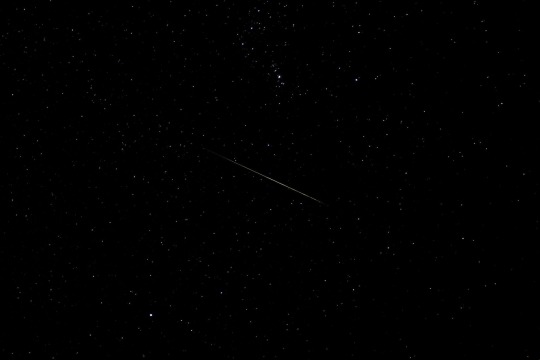
View On WordPress
0 notes
Text
Dos de los primeros cometas interéstelares confirmados por el HUBBLE
El Telescopio Espacial Hubble de la NASA les ha dado a los astrónomos su mejor vistazo hasta ahora a un visitante interestelar, el cometa 2I/Borisov, cuya velocidad y trayectoria indican que proviene de más allá de nuestro sistema solar.
Esta imagen del Hubble, tomada el 12 de octubre de 2019, es la vista más nítida del cometa hasta la fecha. El Hubble revela una concentración central de polvo…
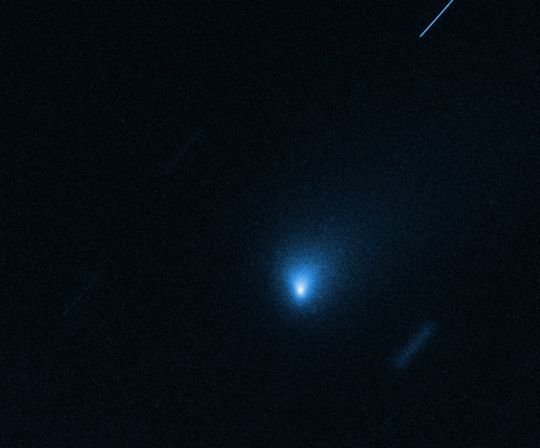
View On WordPress
0 notes
Text
Second interstellar object ever found came from a twin star system
0 notes
Photo
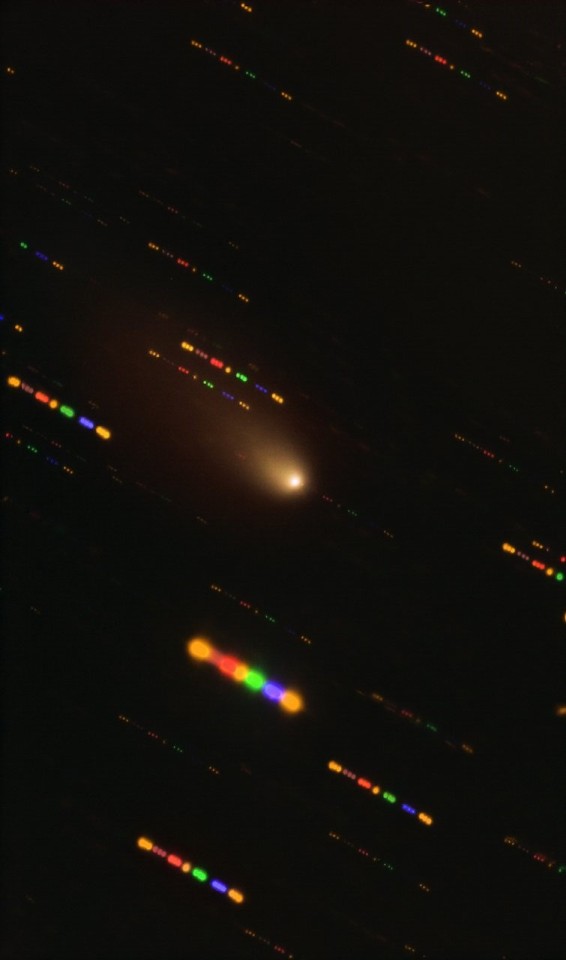
Interstellar Comet and Disco Stars
104 notes
·
View notes
Text
First identified comet to visit our solar system from another star
When astronomers see something in the universe that at first glance seems like one-of-a-kind, it's bound to stir up a lot of excitement and attention. Enter comet 2I/Borisov. This mysterious visitor from the depths of space is the first identified comet to arrive here from another star. We don't know from where or when the comet started heading toward our Sun, but it won't hang around for long. The Sun's gravity is slightly deflecting its trajectory, but can't capture it because of the shape of its orbit and high velocity of about 100,000 miles per hour.
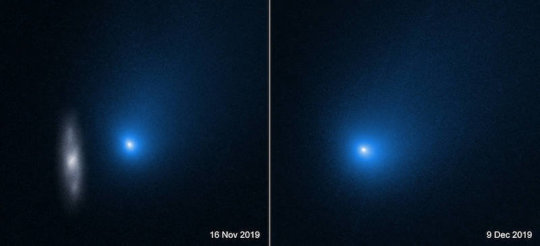
Telescopes around the world have been watching the fleeting visitor. NASA's Hubble Space Telescope has provided the sharpest views as the comet skirts by our Sun. Since October the space telescope has been following the comet like a sports photographer following horses speeding around a racetrack. Hubble revealed that the heart of the comet, a loose agglomeration of ices and dust particles, is likely no more than about 3,200 feet across, about the length of nine football fields. Though comet Borisov is the first of its kind, no doubt there are many other comet vagabonds out there, plying the space between stars. Astronomers will eagerly be on the lookout for the next mysterious visitor from far beyond.
These two images, taken by Hubble, capture comet 2I/Borisov streaking through our solar system and on its way back to interstellar space. It is only the second interstellar object known to have passed through the solar system.
Nov. 16, 2019, photo

The comet appears in front of a distant background spiral galaxy (2MASX J10500165-0152029). The galaxy's bright central core is smeared in the image because Hubble was tracking the comet. Comet Borisov was approximately 203 million miles from Earth in this exposure. Its tail of ejected dust streaks off to the upper right. The comet has been artificially colored blue to discriminate fine detail in the halo of dust, or coma, surrounding the central nucleus. It also helps to visually separate the comet from the background galaxy.
Dec. 9, 2019, photo
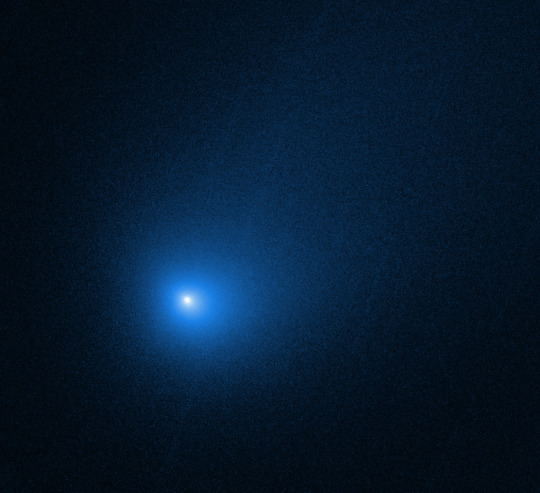
Hubble revisited the comet shortly after its closest approach to the Sun where it received maximum heating after spending most of its life in frigid interstellar space. The comet also reached a breathtaking maximum speed of about 100,000 miles per hour. Comet Borisov is 185 million miles from Earth in this photo, near the inner edge of the asteroid belt but below it. The nucleus, an agglomeration of ices and dust, is still too small to be resolved. The bright central portion is a coma made up of dust leaving the surface. The comet will make its closest approach to Earth in late December at a distance of 180 million miles.
"Hubble gives us the best upper limit of the size of comet Borisov's nucleus, which is the really important part of the comet," said David Jewitt, a UCLA professor of planetary science and astronomy, whose team has captured the best and sharpest look at this first confirmed interstellar comet. "Surprisingly, our Hubble images show that its nucleus is more than 15 times smaller than earlier investigations suggested it might be. Our Hubble images show that the radius is smaller than half a kilometer. Knowing the size is potentially useful for beginning to estimate how common such objects may be in the solar system and our galaxy. Borisov is the first known interstellar comet, and we would like to learn how many others there are."
Crimean amateur astronomer Gennady Borisov discovered the comet on Aug. 30, 2019, and reported the position measurements to the International Astronomical Union's Minor Planet Center in Cambridge, Massachusetts. The Center for Near-Earth Object Studies at NASA's Jet Propulsion Laboratory in Pasadena, California, working with the Minor Planet Center, computed an orbit for the comet, which shows that it came from elsewhere in our Milky Way galaxy, point of origin unknown.
Nevertheless, observations by numerous telescopes show that the comet's chemical composition is similar to the comets found inside our solar system, providing evidence that comets also form around other stars. By the middle of 2020 the comet will have already zoomed past Jupiter's distance of 500 million miles on its way back into the frozen abyss of interstellar space.
116 notes
·
View notes
Video
youtube
1 note
·
View note
Link
The second space rock seen visiting our solar system from another star is proving just how bizarre the first known interstellar object, ‘Oumuamua, really was.
‘Oumuamua raised eyebrows when it appeared in October 2017 looking more like a rocky asteroid than an icy comet (SN: 10/27/17). Because comets form farther from their host stars than asteroids, it should be easier for comets to escape their star’s gravity to wander the galaxy. So astronomers expect the vast majority of interstellar vagabonds to be icy bodies. But ‘Oumuamua didn’t sport the gaseous halo or tail that forms when sunlight vaporizes a comet’s ice.
Now, new telescope images confirm that a second interstellar object called 2I/Borisov (originally dubbed C/2019 Q4 (Borisov)) looks like a garden-variety comet, researchers report online October 14 in Nature Astronomy. The cometlike appearance of this object, first glimpsed August 30, suggests that ‘Oumuamua’s weirdness was a one-off, and that astronomers’ models of planetary systems are on the right track (SN: 9/12/19).
Astronomers observed 2I/Borisov on two nights in September with the William Herschel Telescope in the Spanish Canary Islands and the Gemini North Telescope in Hawaii. Those images reveal that, like comets native to our solar system, 2I/Borisov’s core is shrouded in a gaseous halo trailed by a faint, broad stream of gas and dust.

The first known interstellar object, ‘Oumuamua, appeared to be a naked space rock (left, center). But 2I/Borisov (right, center) bears the usual characteristics of a comet: It’s cloaked in a halo of vaporizing gas and trailing a gaseous tail in its wake.
CREDIT: GEMINI OBSERVATORY/NSF/AURA; ALAN FITZSIMMONS/ARC/QUEEN’S UNIVERSITY BELFAST, ISAAC NEWTON GROUP, NASA
“It’s kind of relieving that finally we have something that meets our expectations,” says study coauthor Michał Drahus, an astronomer at Jagiellonian University in Kraków, Poland. “Now we really can be absolutely sure that ‘Oumuamua was one weird object.”
Whereas ‘Oumuamua vanished within weeks of its discovery, astronomers have several months to take a closer look at 2I/Borisov. Higher-resolution telescope images may tease out the exact size and shape of its core, and inspecting the specific wavelengths of light emanating from the comet could help astronomers flesh out its chemical composition.
Preliminary wavelength observations have already hinted that 2I/Borisov contains cyanogen gas (made of carbon and nitrogen atoms), which is relatively common in comets native to the solar system. Astronomer Alan Fitzsimmons of Queen’s University Belfast in Northern Ireland and colleagues report these findings October 2 at arXiv.org.
30 notes
·
View notes
Text
youtube
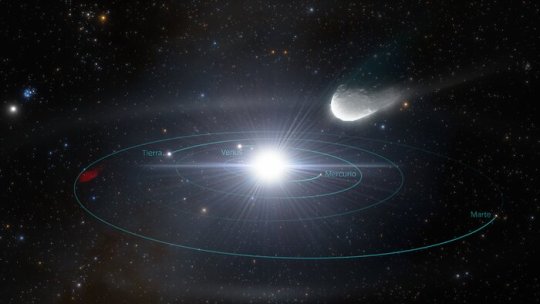
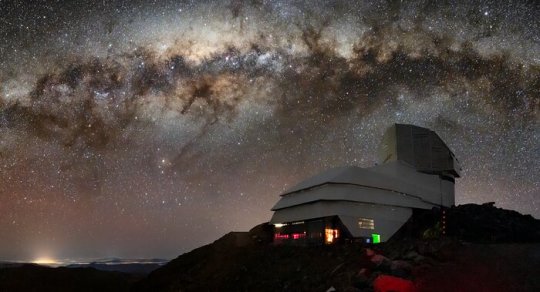
Visitors from Distant Stars: Rubin Observatory Will Detect an Abundance of Interstellar Objects Careening Through Our Solar System
Vera C. Rubin Observatory’s Legacy Survey of Space and Time will revolutionize Solar System science by revealing a population of previously undiscovered interstellar comets and asteroids passing through our cosmic neighborhood.
Many as-yet-undiscovered interstellar objects exist throughout our Milky Way Galaxy: comets and asteroids that have been ejected from their home star systems. Some of these objects pass through our Solar System, bringing valuable information about how planetary systems form and evolve. Currently, only two such interstellar visitors have been discovered: 1I/ʻOumuamua and comet 2I/Borisov. Rubin’s upcoming Legacy Survey of Space and Time will show us many more.
We’ve learned a lot about the biggest, brightest objects in our Solar System using existing instruments and telescopes. However, astronomers like Michele Bannister, Rutherford Discovery Fellow at the University of Canterbury in Aotearoa New Zealand and member of the Rubin Observatory/LSST Solar System Science Collaboration, want to search deeper, for small, faint bodies that originated in planetary systems far beyond our own. These interstellar objects — which were flung from their home systems into the space between stars — are so faint that they have been virtually undetectable. But with the upcoming Legacy Survey of Space and Time (LSST), conducted with Vera C. Rubin Observatory in Chile, scientists are expecting an explosive period of discovery as these faint objects come into view for the first time.
Rubin Observatory is jointly funded by the National Science Foundation (NSF) and the US Department of Energy (DOE). Rubin is a Program of NSF’s NOIRLab, which, along with SLAC National Accelerator Laboratory, will operate Rubin.
The origins of our Solar System lay in a massive swirling cloud of gas and dust that collapsed to form new stars, one of which was our Sun. The stars gobbled up most of the cosmic ingredients, but around each star the remainder formed the small building blocks of planets — called planetesimals — ranging from tens of meters to a few kilometers in size. Some of these coalesced into planets and their moons and rings, but trillions of leftover planetesimals continued to orbit their host stars.
With the aid of observations of our Solar System and computer simulations, scientists speculate that the gravity of larger planets and passing nearby stars often launches most of these remnant planetesimals away from their home systems and out into their galaxies. Traveling through space and not bound to any star, they’re now known as interstellar objects.
“Planetary systems are a place of change and growth, of sculpting and reshaping,” said Bannister. “And planets are like active correspondents in that they can move trillions of little tiny planetesimals out into galactic space.”
If planets are the correspondents, interstellar objects are the telegrams containing valuable information about distant planetary systems and how they formed. And for a short time, some of these messages from afar are right in our cosmic backyard. “A rock from another solar system is a direct probe of how planetesimal formation took place at another star,” said Bannister, “so to actually have them come to us is pretty neat.”
Though astronomers think many interstellar objects exist, and likely pass through our Solar System on a regular basis, only two have been confirmed: ʻOumuamua in 2017 (also known as 1I/2017 U1), and the comet 2I/Borisov in 2019. These were discovered thanks to great timing, a lot of effort, and a little luck — these small, faint interstellar travelers are only visible when they’re close enough to see, and when our telescopes are pointing in the right place at the right time.
“We calculate that there are a whole lot of these little worlds in our Solar System right now,” said Bannister. “We just can't find them yet because we aren’t seeing faint enough.”
Rubin Observatory will change that. Using an 8.4-meter telescope equipped with the highest resolution digital camera in the world, Rubin will detect fainter interstellar objects than we’ve ever seen before. “It’s as though you suddenly go from being on a little boat bobbing around in the beautiful shallows just off the shore, to now you’re out over the big deep ocean and you can see into all that expanse for the first time,” said Bannister.
Additionally, Rubin's fast-moving telescope can scan the entire visible sky every few nights, capturing a timelapse view of interstellar objects on their fast journeys through our Solar System.
While we call both ‘Omuamua and 2I/Borisov interstellar objects, they differ in just about every way we can measure. What will the third, or the twentieth, interstellar object look like? Within the first year of Rubin Observatory’s 10-year LSST, scheduled to begin in 2025, scientists expect to get a good idea. “We’re going to go from a study of two individual objects to a population study of at least dozens,” Bannister said. As interstellar objects could come from stars all across the Milky Way, this increase will allow scientists to directly study how planetary systems form at distant stars throughout our galaxy’s history — including at ancient stars that no longer exist.
For now, scientists can only make loose predictions of how many interstellar objects Rubin will reveal. Bannister playfully places her bet on 21, but says we really have no idea yet. Whatever the outcome, Rubin is poised to revolutionize Solar System studies — along with many other areas of astronomy and astrophysics. “It’s going to be one of the gifts that Rubin provides,” she said, “a new history of the Solar System and a greater understanding of where we come from.”
More information
Rubin Observatory is a joint initiative of the National Science Foundation (NSF) and the Department of Energy (DOE). Its primary mission is to carry out the Legacy Survey of Space and Time, providing an unprecedented data set for scientific research supported by both agencies. Rubin is operated jointly by NSF’s NOIRLab and SLAC National Accelerator Laboratory (SLAC). NOIRLab is managed for NSF by the Association of Universities for Research in Astronomy (AURA) and SLAC is operated for DOE by Stanford University. Additional contributions from a number of international organizations and teams are acknowledged.
The National Science Foundation (NSF) is an independent federal agency created by Congress in 1950 to promote the progress of science. NSF supports basic research and people to create knowledge that transforms the future.
SLAC is operated by Stanford University for the U.S. Department of Energy’s Office of Science. The Office of Science is the single largest supporter of basic research in the physical sciences in the United States and is working to address some of the most pressing challenges of our time.
NSF’s NOIRLab (National Optical-Infrared Astronomy Research Laboratory), the US center for ground-based optical-infrared astronomy, operates the international Gemini Observatory (a facility of NSF, NRC–Canada, ANID–Chile, MCTIC–Brazil, MINCyT–Argentina, and��KASI–Republic of Korea), Kitt Peak National Observatory (KPNO), Cerro Tololo Inter-American Observatory (CTIO), the Community Science and Data Center (CSDC), and Vera C. Rubin Observatory (in cooperation with DOE’s SLAC National Accelerator Laboratory). It is managed by the Association of Universities for Research in Astronomy (AURA) under a cooperative agreement with NSF and is headquartered in Tucson, Arizona. The astronomical community is honored to have the opportunity to conduct astronomical research on Iolkam Du’ag (Kitt Peak) in Arizona, on Maunakea in Hawai‘i, and on Cerro Tololo and Cerro Pachón in Chile. We recognize and acknowledge the very significant cultural role and reverence that these sites have to the Tohono O’odham Nation, to the Native Hawaiian community, and to the local communities in Chile, respectively.
TOP VIDEO....This video shows the paths through our Solar System of the two confirmed interstellar objects, 'Oumuamua (formally known as 1I/2017 U1), discovered in 2017, and the comet 2I/Borisov, discovered in 2019. The paths of these objects are markedly different than the orbits of objects in our Solar System, making them easy to differentiate as interstellar objects. Rubin Observatory and the Legacy Survey of Space and Time will provide data that enables scientists to identify many interstellar objects early in the survey. Credit: Rubin Observatory/NSF/AURA/J. Pinto
TOP IMAGE....Alt-Text: An artist’s impression of a small, rocky interstellar object hurtling from the upper right toward the inner Solar System. The orbits of the four inner planets (Mercury, Venus, Earth, Mars) are fully visible, drawn as teal concentric circles around the bright ball of the Sun at the center. We see the orbits from a slightly elevated angle, so that the circular paths appear oval. The black background is sprinkled with points of starlight. The interstellar object looks like an elongated potato above the Sun, streaming toward the Sun from the upper right, with a short tail of gas and dust trailing behind. Credit:Rubin Observatory/NOIRLab/NSF/AURA/J. daSilva
LOWER IMAGE....This image captures not only Vera C. Rubin Observatory, a Program of NSF’s NOIRLab, but one of the celestial specimens Rubin Observatory will observe when it comes online: the Milky Way. The bright halo of gas and stars on the left side of the image highlights the very center of the Milky Way galaxy. The dark path that cuts through this center is known as the Great Rift, because it gives the appearance that the Milky Way has been split in half, right through its center and along its radial arms. In fact, the Great Rift is caused by a shroud of dust, which blocks and scatters visible light. This dust makes the Great Rift a difficult space to observe. Fortunately, Rubin is being built to conduct the Legacy Survey of Space and Time (LSST). This survey will observe the entire visible southern sky every few nights over the course of a decade, capturing about 1000 images of the sky every night and giving us a new view of our evolving Universe. The LSST is set to probe four areas of science, one of which is mapping the Milky Way to answer questions about its structure and formation. Once Rubin Observatory comes online in 2024, scientists will be able to access the data taken every night of operation. Rubin Observatory is a joint initiative of the National Science Foundation and the Department of Energy (DOE). Once completed, Rubin will be operated jointly by NSF’s NOIRLab and DOE's SLAC National Accelerator Laboratory to carry out the Legacy Survey of Space and Time. Credit:RubinObs/NOIRLab/NSF/AURA/B. Quint
1 note
·
View note
